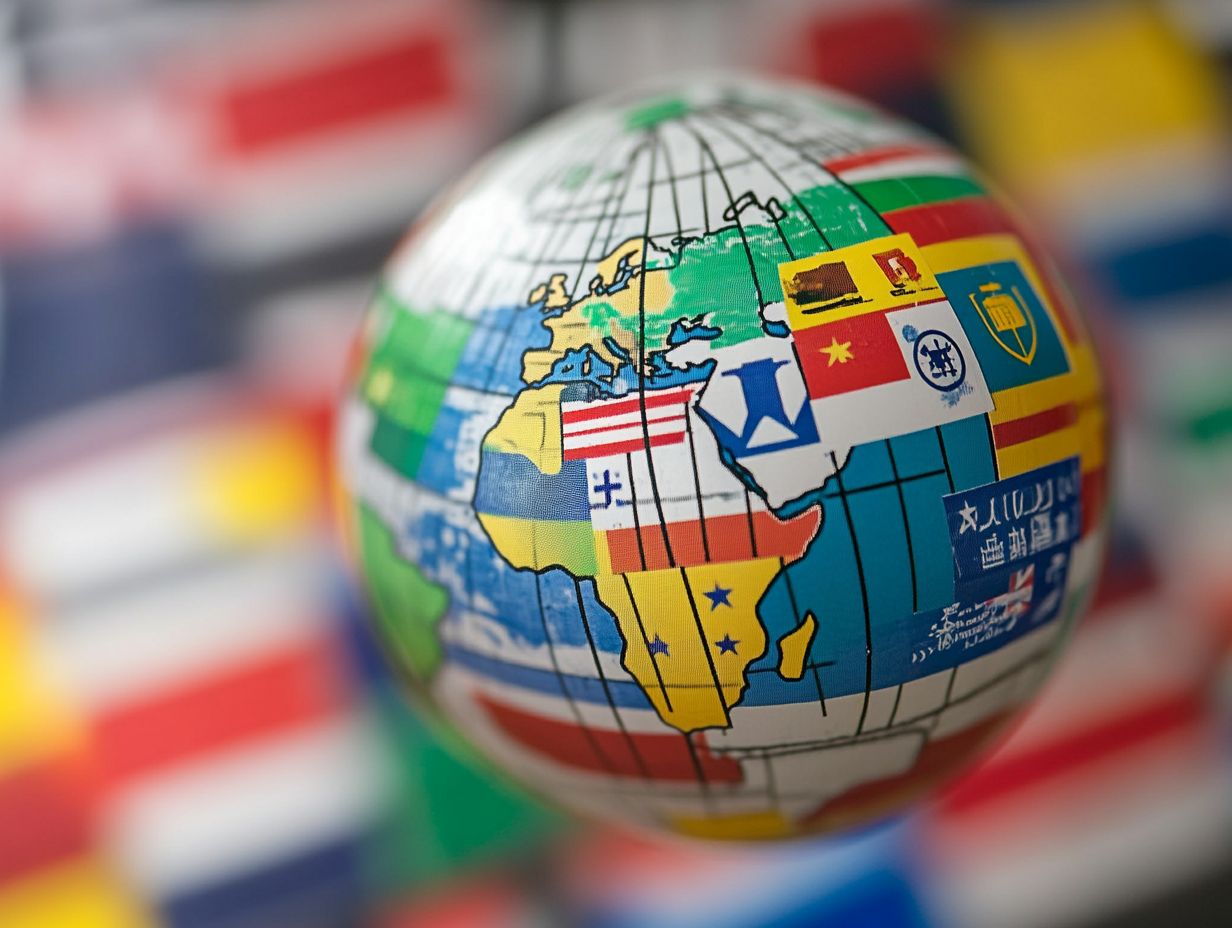5 Key Elements of International IP Agreements
Understanding intellectual property can unlock new opportunities for your business! Intellectual property (IP) is vital for nurturing innovation and creativity in today’s global economy.
For businesses like yours, grasping the intricacies of international IP agreements is essential when navigating the complex landscape of global markets. This article delves into five key elements that shape these agreements:
- Defining intellectual property
- Understanding the scope of protection
- Outlining rights and obligations
- Examining enforcement mechanisms
- Discussing dispute resolution
You’ll also discover the various types of agreements, important negotiation considerations, common challenges, and effective strategies for protection. Explore with us the significance of international IP agreements and how they can benefit your business while helping you navigate potential risks.
Contents
- Key Takeaways:
- 1. Definition of Intellectual Property
- 2. Scope of Protection
- 3. Rights and Obligations of Parties
- 4. Enforcement Mechanisms
- 5. Dispute Resolution
- What Are International IP Agreements and Why Are They Important?
- What Are the Different Types of International IP Agreements?
- What Are the Key Considerations When Negotiating an International IP Agreement?
- What Are the Common Challenges in Implementing International IP Agreements?
- How Can Businesses Protect Their Intellectual Property in International Markets?
- What Are the Potential Benefits and Risks of International IP Agreements?
- Frequently Asked Questions
- What are the 5 key elements of international IP agreements?
- Why is scope and coverage an important element of international IP agreements?
- How does ownership and rights play a role in international IP agreements?
- What is the significance of enforcement in international IP agreements?
- How does dispute resolution function in international IP agreements?
- Why is international cooperation a crucial element of IP agreements?
Key Takeaways:

International IP agreements are crucial for protecting your rights across borders. Understanding how to negotiate these agreements can give your business a significant advantage.
1. Definition of Intellectual Property
Intellectual property (IP) includes a variety of legal rights designed to protect the creations of your mind, such as patents, copyrights, trademarks, and industrial designs.
These rights allow you to safeguard your inventions and artistic works within a framework shaped by various international agreements, like the TRIPS Agreement, which sets minimum standards for IP protection globally.
Patents grant you exclusive rights for your new inventions, allowing you to capitalize on your ideas for a defined period. Copyrights shield your original works, giving you control over how your music, literature, and other creative expressions are used.
Trademarks act as identifiers for your brand, enabling consumers to easily distinguish your products and services in a crowded marketplace. Industrial designs focus on the aesthetic elements of manufactured items, marrying functionality with beauty.
The TRIPS Agreement plays a vital role in harmonizing global IP standards. It collaborates with established conventions such as WIPO, the Paris Convention, and the Berne Convention to create a cohesive framework that fortifies international protection for these essential rights.
2. Scope of Protection
The scope of protection for intellectual property rights varies significantly among patents, copyrights, and trademarks. This is clearly outlined in the TRIPS Agreement, which emphasizes the principles of national treatment and most-favored-nation, ensuring equitable enforcement among member countries.
These principles require that each country offers the same level of protection to foreign intellectual property holders as it does to its own citizens, fostering a fair trade environment. When a country enforces robust patent laws, multinational corporations gain confidence that their innovations will be adequately safeguarded, encouraging technological advancements.
When a member state adopts the most-favored-nation principle, it must extend any favorable treatment granted to one member to all, enhancing cooperation and potentially leading to broader economic benefits. These protections not only help prevent infringement but also stimulate research and development, making the global marketplace more dynamic and competitive.
Don t wait! Secure your ideas today!
3. Rights and Obligations of Parties
The TRIPS Agreement clearly outlines the rights and obligations that you, as a Member country, must uphold regarding intellectual property. It mandates establishing effective enforcement mechanisms while granting crucial rights to IP holders.
This framework acts as a cornerstone for international trade. It ensures that creators and innovators like you are recognized and compensated for your valuable contributions. The rights conferred include exclusive control over the use and distribution of various intellectual properties, safeguarding the fruits of your ingenuity.
As a Member country, you must develop and implement appropriate legal tools think civil and criminal penalties to deter any IP infringement. Access to these procedures and remedies is essential for businesses operating globally. It creates a safe space that encourages investment and innovation, ultimately enhancing your competitive advantage in the marketplace.
4. Enforcement Mechanisms

Enforcement mechanisms under the TRIPS Agreement are pivotal in safeguarding intellectual property. They establish robust measures, including:
- Border controls
- Criminal procedures
- Provisional measures
These tools streamline the enforcement process and create a more reliable framework for you as an IP owner to protect your rights effectively. For example, border measures empower customs authorities to seize infringing goods right at importation points, preventing them from entering the market.
Criminal procedures introduce punitive actions for those who breach intellectual property rights. They serve to discourage further violations while underscoring the seriousness of such offenses. Provisional measures offer an additional layer of protection, enabling you to safeguard your interests swiftly while legal proceedings unfold.
This ensures that your rights remain intact during what can often be a lengthy litigation process. Together, these enforcement strategies significantly enhance compliance rates and affirm the legitimacy of IP rights in the global marketplace.
5. Dispute Resolution
Effective dispute resolution mechanisms outlined in the TRIPS Agreement are crucial for you to navigate conflicts between Member countries concerning intellectual property rights. They provide structured procedures and remedies that promote international trade and cooperation.
These mechanisms establish a vital framework ensuring that disputes over intellectual property like patents and trademarks are resolved fairly and efficiently. Organizations such as the World Intellectual Property Organization (WIPO) play a significant role in mediating these conflicts. They offer arbitration and conciliation services that help you reach amicable solutions.
By cultivating an environment where IP rights are respected and enforced, these mechanisms safeguard the interests of intellectual property holders. They also foster innovation and economic development across borders.
Ultimately, the effective implementation of these dispute resolution processes enhances global trust. It ensures that all parties adhere to established IP norms, thereby strengthening international trade relations.
What Are International IP Agreements and Why Are They Important?
International IP agreements are essential legal frameworks established by treaties like the TRIPS Agreement, WIPO, Paris Convention, and Berne Convention. These treaties aim to standardize the protection of intellectual property across Member countries. For a deeper understanding, consider exploring 5 key insights into international patent practices. This facilitates international trade and fosters innovation, creating a stable environment for IP rights holders.
These agreements play a crucial role in harmonizing laws and ensuring that you, as a creator, receive adequate protection for your inventions, trademarks, and artistic works, regardless of where they are produced or marketed. By establishing common standards, they help reduce trade barriers and create a level playing field, ultimately encouraging technological advancement.
For example, the TRIPS Agreement sets minimum standards for IP protection, while the Berne Convention guarantees that authors retain rights over their literary and artistic works worldwide. Together, these frameworks enhance synergy among various agreements, safeguarding your interests as an innovator and bolstering the global economy through increased trade opportunities.
Explore how these mechanisms can protect your creativity today!
What Are the Different Types of International IP Agreements?
Various international IP agreements exist. These include the TRIPS Agreement, WIPO, the Paris Convention, the Berne Convention, and the IPIC Treaty. For a deeper understanding, check out the 5 key takeaways from successful IP strategies, as each agreement serves distinct yet complementary purposes in establishing and enforcing standards for the protection of intellectual property rights worldwide.
Each agreement tackles specific aspects of intellectual property, contributing to a more cohesive global framework. For instance, the TRIPS Agreement sets minimum standards for copyrights, patents, and trademarks. It ensures that member countries provide adequate legal protections, aligning with the 5 most effective strategies for IP protection globally.
The Berne Convention focuses on copyright protection, championing the rights of authors on an international scale. The Paris Convention, on the other hand, mainly focuses on the protection of industrial property, including patents and trademarks.
Together, these agreements interact to create uniformity. This safeguard not only protects the rights of creators and inventors but also facilitates international trade and cooperation. Their interplay underscores their significant role in fostering a robust global IP environment.
What Are the Key Considerations When Negotiating an International IP Agreement?

When you negotiate international IP agreements, it s crucial to consider the delicate balance between enforcing intellectual property rights and the broader implications for technological innovation and public health. This is particularly important among diverse member countries with their unique needs and capacities.
In this intricate landscape, the principle of treating foreign stakeholders the same as local ones is essential. It fosters an equitable environment for all participants. A principle that ensures fair treatment for all countries involved enhances this framework. It promotes non-discriminatory practices, encouraging a wider range of participants in the negotiation process.
Transitional arrangements may be necessary, allowing emerging economies the essential time to adapt their systems without sacrificing their developmental aims. Flexibility is vital; tailoring your approach to different socio-economic contexts can significantly influence the outcome of these negotiations.
Focusing on public health is vital. It guarantees that your agreements promote innovation while ensuring access to essential medicines and technologies.
What Are the Common Challenges in Implementing International IP Agreements?
Implementing international IP agreements often presents a range of challenges for member countries. These include disparities in enforcement capabilities, varying levels of technological innovation, and conflicts with public health objectives.
Limited resources further complicate these issues. They hinder your nation s ability to adequately enforce and comply with intellectual property laws. Legal inconsistencies can create confusion, making it increasingly difficult for stakeholders to navigate the regulatory landscape.
There is a pressing need for capacity building to ensure that your country can effectively manage its IP framework while also addressing public health necessities. You must invest financially to balance these needs. Establishing education and support systems is crucial to enhancing understanding of international laws.
By doing so, nations can safeguard innovation while meeting the health needs of their populations.
How Can Businesses Protect Their Intellectual Property in International Markets?
You can effectively protect your intellectual property in international markets by employing strategies such as thorough trademark registration, copyright protection, and exploring licensing opportunities to ensure compliance with local laws and enforcement mechanisms.
To enhance your protection efforts, consider conducting regular intellectual property audits. These audits help you identify and assess existing assets, shining a light on any vulnerabilities you might have. Understanding local IP laws is essential, as regulations can vary widely from one country to another. Seeking legal counsel in each jurisdiction can be invaluable.
Forming strategic partnerships with local firms can offer insights and resources necessary to navigate these complexities. By taking these proactive measures, you not only safeguard your assets but also cultivate a culture of compliance, giving you the power to effectively enforce your rights across diverse markets.
What Are the Potential Benefits and Risks of International IP Agreements?
International IP agreements provide a mix of potential benefits and risks that should be carefully considered. They can enhance the protection of creations and ideas and encourage technological innovation.
However, many worry that these agreements could exacerbate public health crises in member countries due to overly restrictive enforcement. By establishing a framework for protecting inventions and creative works, they often improve market access for local businesses, encouraging exploration of global markets and investment in research and development.
This same framework can limit access to essential medicines, especially in countries where patent laws hinder the production of affordable generics. Local industries may struggle to compete against established international brands.
The stringent protection of intellectual property can hinder traditional practices and innovations, creating a challenging landscape. While there is undeniable potential for economic growth and technological advancement, finding a fair balance between protection and accessibility remains a crucial concern for policymakers.
Frequently Asked Questions

What are the 5 key elements of international IP agreements?
The 5 key elements are: scope and coverage, ownership and rights, enforcement, dispute resolution, and international cooperation.
Why is scope and coverage an important element of international IP agreements?
Scope and coverage determine how widely the agreement applies to different types of creations and ideas, such as patents, trademarks, and copyrights. This ensures that all forms of IP are protected and promotes fair competition.
How does ownership and rights play a role in international IP agreements?
Ownership and rights define who legally owns and controls the creations and ideas. This helps prevent disputes and ensures that creators are recognized and compensated for their work.
What is the significance of enforcement in international IP agreements?
Enforcement ensures that the rights granted under the agreement are protected and provides mechanisms for addressing violations. This maintains the integrity and value of intellectual property rights.
How does dispute resolution function in international IP agreements?
Dispute resolution provides a process for resolving conflicts regarding intellectual property rights. This promotes fair and efficient resolution of disputes, avoiding costly legal battles.
Why is international cooperation a crucial element of IP agreements?
International cooperation encourages collaboration between countries in protecting and enforcing intellectual property rights. This creates a global framework for the protection of creations and ideas, promoting innovation and economic growth.
Stay informed about how these agreements impact your industry!






